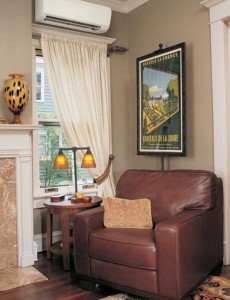 “Do I have a healthy home?” Most of us would like to know the answer to this question. However, we aren’t sure what qualifies as “healthy.”
“Do I have a healthy home?” Most of us would like to know the answer to this question. However, we aren’t sure what qualifies as “healthy.”
The experts at Energy Efficiency First believe air quality is the number priority to address in achieving a healthy home. This is true whether your home is new or old. EEF provides practical, affordable solutions to ensure your home is safe, healthy, comfortable, and durable.
Many things affect a home’s air quality.
The rate at which your home ventilates air in and out can dramatically affect air quality. Homes with higher ventilation rates experience less buildup of contaminants and moisture. Contaminants can come from indoor sources, such as building materials made with formaldehyde or paints made with volatile organic compounds. Contaminants, such as pollen or smog, can also come from outside. Moisture from crawl spaces and basements can also contribute to unhealthy indoor air quality. A well ventilated home will fully exhaust these contaminants and reduce adverse health effects.
If ventilation rates are too high, however, energy efficiency is compromised. The Goldilocks rate of ventilation allows one complete exchange between indoor and outdoor air once every three hours.
If a blower door test reveals the building envelope is too leaky, strategic air sealing can be done, and even coupled with mechanical heat recovery ventilation systems. If the test shows the envelope is too tight, strategically located sources of mechanical and passive ventilation can be added.
It is also important to control the source of the incoming air, making sure it is from healthy sources. It is necessary to control the unintentional introduction of outside air, that typically come in through cracks in the building envelope, to assure it does not bring in unwanted contaminants or moisture. These sources may include basements, crawl spaces, and garages. Infiltration is caused by wind, stack effect, and mechanical air handling equipment in the home.
The “stack effect” is when warm air moves upward in a building. This is most pronounced in the winter because indoor-outdoor temperature differences are the greatest. When indoor air is warmer than the outdoor air, it escapes out of the upper levels, through open windows, ventilation openings, or penetrations and cracks in the building envelope. The rising warm air reduces the pressure in the base of the building, forcing cold air to infiltrate through low openings. The stack effect basically causes air infiltration on the lower portion of a building and exfiltration on the upper part.
 Mechanical equipment, such as an exhaust fan or clothes dryer, will move air in a manner than can generate air pressure differences: if more air is exhausted from the home than is supplied, a net negative pressure is generated that will draw air through cracks in the building envelope, often from unwanted sources.
Mechanical equipment, such as an exhaust fan or clothes dryer, will move air in a manner than can generate air pressure differences: if more air is exhausted from the home than is supplied, a net negative pressure is generated that will draw air through cracks in the building envelope, often from unwanted sources.
Pressure imbalances can also cause carbon monoxide backdraft into the home from combustion appliances, such as gas stoves, dryers, and furnaces. Under the “right” circumstances, the simple act of closing a door or turning on a bath fan can create negative pressure that causes air to flow into the home through combustion appliance exhaust flus, putting people at risk of carbon monoxide poisoning.
Filtering the air is also important. Filtering particles that come from both outdoor air and indoor sources is an important part of maintaining healthy indoor air and reducing adverse health effects.
Using specialized diagnostic equipment and building science expertise, EEF can help bring your home to a state of Goldilocks. The ultimate goal is to pull fresh, healthy air into the home from appropriate sources and to push the old or used air out. With the right combination of high and low air sealing, passive fresh air vents, mechanical ventilation, heat recovery ventilation systems, and air filtration, EEF can assure your home is comfortable, energy efficient, and a healthier place to breathe.
So, DO YOU have a healthy home with adequate ventilation? Call Energy Efficiency First and ask for a blower door test.
For more information contact Energy Efficiency First at 360-239-9684 or visit them online.





















































